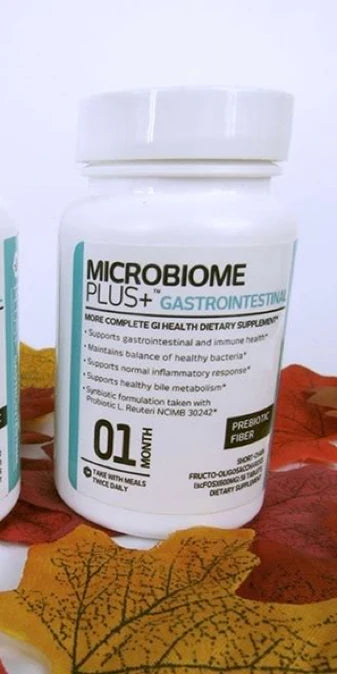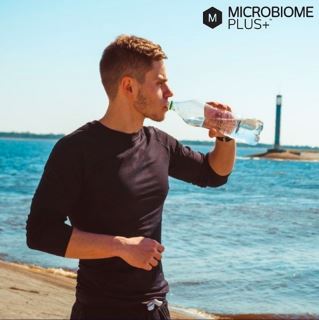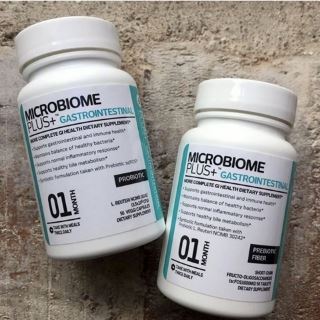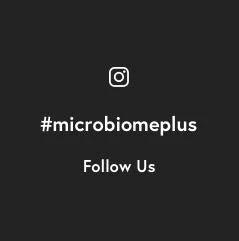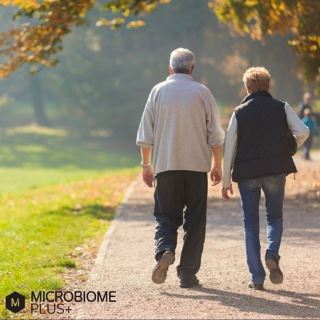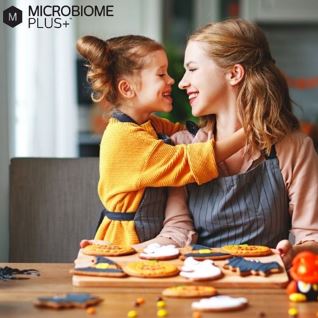Can you take prebiotics and probiotics at the same time—and why would you want to? If you are eager to get the most out of your prebiotic and probiotic supplements, this step-by-step guide is for you. We go over the complete research, with a special focus on our science-based synbiotic combination: scFOS prebiotic fiber and L. reuteri NCIMB 30242 probiotics.
Disclaimer: This post is for informational purposes only. Please discuss your health concerns with your care provider and consult them before taking any supplements to avoid disease and drug interactions.
How To Take Prebiotics And Probiotics Together For Best Results
1. Choose an Evidence-Based Synbiotic (Prebiotic and Probiotic Combination)
Prebiotics and probiotics together: Getting down to the basics
To recap:
- Probiotics are good bacteria— living microorganisms that normally reside in your body. The good gut bacteria that reside in your colon are collectively known as your gut microbiome (Floch, 2014).
- Prebiotics are indigestible food ingredients that feed the good gut bacteria in your colon, rebalancing your microbiome.
What are Synbiotics?
Prebiotics and probiotics work together in synergy, one enhancing the effects of the other. Evidence-based synergistic combinations of prebiotics and probiotics are also known as synbiotics (Markowiak & Śliżewska, 2017).
Many probiotic benefits are strain-specific. The health benefits of fiber supplements can also wildly vary depending on the type of fiber you’re taking. Not all fiber and probiotics are the same, and the combination you decide to take can make all the difference.
That’s why choosing the right product is crucial. So, be sure to pick a probiotic and prebiotic supplement combination that has been through human research and is manufactured by a trusted brand.
Best Synbiotic Supplements
Microbiome Plus Prebiotic and Probiotic Combo contains the following research-based synbiotic combination:
- Short-term fructooligosaccharides (scFOS), a subtype of FOS prebiotic fiber with clinically proven benefits on the gut flora (Bouhnik et al., 2007, Bouhnik et al., 2006).
- L. Reuteri NCIMB 30242, a clinically tested probiotic strain with unique benefits like supporting optimal cholesterol, vitamin D, and C-reactive protein (CRP) levels
Fructooligosaccharides (FOS) are a type of fiber that exists in about 36,000 plants. FOS have been researched for enhancing the benefits of probiotics in the large intestine (Mao et al., 2018).
Also, our probiotic has been clinically researched for resisting stomach acid and comes in delayed-release capsules. This is important since probiotics are wired to survive in your colon (pH 6 to 7) and usually don’t do well in an acidic environment.
Scientists developed L. reuteri NCIMB 30242 to be more tolerant to the hostile environment of the gastrointestinal tract than other probiotics. Our strain can increase its own survival by detoxing bile acids (being bile salt hydrolase (BSH) active). Microencapsulation ensures that freed bile acids get cleared from the body with no negative effects (Del Piano et al., 2011; Begley et al., 2006; Jones et al., 2004; Kurdi et al., 2000).

2. Take the Right Dosage with Light, Fiber-Rich Meals
Dosage
The dosage of Lactobacillus reuteri NCIMB 30242 used in clinical trials was 2.9×10⁹ CFU per capsule, twice daily (Jones et al., 2012).
Our L. reuteri NCIMB 30242 contains 3.5×10⁹ CFU per capsule. This is 21% more than the clinically researched dosage, which ensures you get the right amount of probiotics just in case some live bacteria are lost before they reach your colon.Our prebiotic contains 600 mg of concentrated short-term fructooligosaccharides (scFOS) per tablet. According to studies, the optimal and well-tolerated scFOS dose ranges from 2.5 to 10 g/day (Bouhnik et al., 2007, Bouhnik et al., 2006).
Probiotics survive best when taken with fiber-rich meals
Gastrointestinal transit is how long it takes for probiotics to reach your colon from the moment you ingest them. This can be anywhere from 5 minutes to 2 hours (Han et al., 2021).
The typical advice is to take probiotics on an empty stomach because food slows down their transit—that’s what most companies and blog posts will tell you. And it’s wrong!
Here’s why: food helps probiotics survive by neutralizing stomach acid. Exposure to more concentrated stomach acid (low stomach pH) can kill probiotics before they even make it to the intestine. It’s a bigger factor than transit time (Tompkins et al., 2011; Del Piano et al., 2011).
Recent studies on non-enteric coated probiotics showed that (Tompkins et al., 2011):
- Most live bacteria survive when probiotic capsules were given with a light meal (cooked oatmeal with milk) or 30 minutes before
- Probiotics given 30 minutes after the meal did not survive in high numbers
- Survival in milk with 1% fat and oatmeal-milk gruel was better than apple juice or spring water
- The protein content of the meal was not as important
Also, since Lactobacillus probiotics need glucose in an acidic environment like the stomach, they seem to survive better when taken alongside carbs (Corcoran et al., 2005).
Our probiotic is more likely to survive an empty stomach than other commercially available strains and formulations. However, taking it on an empty stomach isn’t ideal.
Prebiotics also work best alongside fiber-rich meals
Traditionally, probiotic foods were an integral part of our diet. Modern animal and human studies also report benefits when prebiotics are added to meals or taken along with meals as part of a healthy, fiber-rich diet (Costa et al., 2021; Respondek et al., 2013; Hess et al., 2011).
Unlike probiotics, prebiotics are resistant to stomach acid and digestive enzymes. That means prebiotics can easily reach your colon, where all your good bacteria live. In the colon, prebiotic fiber gets broken down by probiotics, helping your microbiome diversify and flourish (Guarino et al., 2020).
Both traditional diets and modern research reveal that prebiotics work best when taken with fiber-rich meals.
Examples of fiber-rich foods & meals
Prebiotic fiber boosts the benefits of probiotics, makes live bacteria more tolerant to stomach acid, and supports the growth of a diverse gut microbiome in the colon (Markowiak & Śliżewska, 2017).
Good sources of prebiotic, fiber-rich foods you add to the meals you take your pre and probiotic with include (Davani-Davari et al., 2019; Thursby & Juge, 2017)
- Fruits (bananas, apples, mangos)
- Vegetables (asparagus, chicory, leafy greens, Jerusalem artichokes, garlic, onion)
- Grains (oats, barley, and rye)
- Nuts and seeds (walnuts, almonds, chia, flaxseeds, hazelnuts, hemp seeds)
- Legumes and plant protein (soybean, peas, and beans)
- Seaweeds and microalgae
Resistant starch is similar to prebiotic fiber and is another great addition to a diet that boosts probiotic effectiveness and microbiome diversity (Singh et al., 2019).
Non-fiber antioxidants from fruits and vegetables such as raw cacao and green tea also act as prebiotics (Davani-Davari et al., 2019; Tzounis et al., 2019).
Here are some specific examples of light meals packed with prebiotics:
- Oats with chia seeds, bananas, and blueberries (in coconut, almond, or regular milk)
- Salad with baby spinach, arugula, almonds, apples, cranberries, dried seaweed, and an optional protein source of your choice (e.g. seafood, salmon, tofu)
- Red kidney bean salad with garlic, onion, peppers, corn, and parsley or cilantro sprinkled with olive oil
Skip heavy meals
It can take a long time to digest heavy meals. Heavy food strongly increases stomach acid, bile acids, and digestive enzymes. Four to five hours can pass before the contents of heavy meals reach the colon, so even delayed-release capsules may free the probiotic too early.
For the best results, don’t take our probiotic capsules with or several hours after heavy meals.
In Summary
We recommend taking L. Reuteri NCIMB 30242 probiotic capsules and scFOS prebiotic tablets with fiber-rich, light meals to boost probiotic survivability and synbiotic benefits.
Take 1-3 prebiotic tablets and 1 probiotic capsule two times per day, each with a fiber-rich meal. Adapt your prebiotic dosage to your dietary fiber intake (lower dose if your dietary fiber intake is high).
3. Don’t Forget to Drink Water
Prebiotic fiber attracts and soaks up water. Research shows that scFOS is especially good at attracting water. That’s why you should drink a glass of water along with prebiotic supplements and fiber-rich meals (Camara et al., 2020).
Always drink at least one glass of water with the prebiotic supplement.
4. Space Two Hours Away from Medications
Since prebiotic fiber isn’t digested, it can bind to medications. This may affect the absorption of prescription and over-the-counter (OTC) drugs. For this reason, it’s recommended to take prebiotic supplements at least two hours before or two hours after any medications (Canga et al., 2010).
Consult your doctor or pharmacist before adding a prebiotic supplement to your regular medications to avoid any potential interactions.
If you take any medication, do not take our scFOS supplement at least 2 hours before or after.
5. Up Other Beneficial Foods
Healthy fats
After all these efforts to help probiotics reach your colon, there’s one last question: how can you get the probiotic to stay there?
Colonization resistance is when bacteria indigenous to your colon reject the new probiotic strain. It’s a big and common problem, and if it happens, the supplemented probiotic is removed with the stool without achieving its benefits (Yao et al., 2020; Zmora et al., 2018).
Preliminary studies suggest that the following dietary compounds may help:
- Polyunsaturated fatty acids (PUFA)
- Omega-3 fatty acids
Omega 3 fatty acids and other PUFAS help probiotics “stick” to the gut lining. This is the first step to overcoming colonization resistance (Bomba et el., 2002; Bomba et al., 2003; Han et al., 2021).
Wild-caught fish is rich in omega-3 PUFAs. Plant-based sources of PUFAs include walnut, sunflower seeds, and flaxseeds. These beneficial fats also have anti-inflammatory and heart-protective properties that work in synergy with our probiotic.
Additionally, olive oil may help boost the benefits of both prebiotics and probiotics. It is a nutritious fat that promotes intestinal health and increases the diversity of the gut microbiome. Extra virgin olive oil is an especially good choice for people with high LDL (“bad”) cholesterol and heart disease (Marcelino et al., 2019).
Add moderate amounts of olive oil and foods high in healthy fats to your fiber-rich meals. This may help probiotics integrate into your gut microbiome.
Medicinal foods & spices
Consider adding the following dietary compounds to your diet or supplement regime to help boost the benefits of our probiotic:
- Curcumin
- Medicinal mushrooms
Curcumin is the main active ingredient in the spice turmeric. Aside from being one of the best-researched natural anti-inflammatories, curcumin helps restore gut microbiome balance. Curcumin boosts the growth of beneficial probiotics while reducing the number of pathogenic gut bacteria. Plus, it helps strengthen the gut barrier, which might be helpful for people with leaky gut (Scazzocchio et al., 2020; Di Meo et al., 2019).
You can get curcumin from food (by adding the spice turmeric to your meals) or supplements.
Lastly, edible medicinal mushrooms help balance and enrich the gut microbiome. Mushrooms act as prebiotics and are rich in immune-boosting active compounds. Some sources include Lion’s mane, reishi, shiitake, maitake, turkey tail, and others (Jayachandran et al., 2017; Diling et al., 2017).
Mineral-dense foods
Prebiotics are not only great for gut health, but they’re a potential strategy to overcome mineral deficiencies. That’s why we recommend combining our scFOS prebiotic supplement with mineral-dense meals or, alternatively, mineral dietary supplements (Costa et al., 2021).
According to a review of 30 articles and almost 1500 texts that included human data, scFOS may increase the absorption and/or bioavailability of (Costa et al., 2021):
- Calcium
- Magnesium
- Iron (especially non-heme iron from vegetables that’s harder to absorb)
- Phosphorus
- Calcium
- Zinc
- Copper
- Manganese
Scientists think that FOS fiber works by activating bifidobacteria, which lower the pH of the colon and produce short-chain fatty acids (SCFA) and lactate. Altogether, this helps the body take in and use more nutritionally important minerals from food (Costa et al., 2021).
Here’s the good part: if you up your intake of the fiber-rich foods mentioned in the previous section, you’ll also be consuming plenty of minerals.
Some additional sources of mineral-rich nutritious foods you may want to consider adding to your diet if you’re at risk of deficiency include (Ma & Betts, 2000; NIH magnesium fact sheet; Gopalakrishnan et al., 2016; Farsi & Lee, 2008) :
- Spinach and other leafy greens
- Pumpkin seeds and cashews
- Grass-fed beef
- Seafood
- Moringa
- Dates
If you can’t get enough minerals from food, consider adding multimineral supplements to your regime.
6. Avoid Microbiome Disruptors
Avoid the following foods, they’re known microbiome disruptors (Suez et al., 2014; Singh et al., 2019):
- Trans fats (margarine, deep-fried foods, non-dairy coffee creamer)
- Processed foods
- Artificial sweeteners
- Too much red meat
- Sugars in excess
- Alcohol in excess
In a nutshell, these foods reduce the effectiveness of probiotic supplementation, cause gut dysbiosis, and negatively affect your heart, immune, and overall health.
Some drugs and environmental toxins can also act as microbiome disruptors, including antibiotics, hormones, cigarettes, and many chemicals (dioxins, pesticides, pyrethroids, polychlorinated biphenyls (PCBs), flame retardants, plasticizers) (Ramirez et al., 2020; Aguilera et al., 2020).
If you’re worried about drug interactions and side effects, be sure to discuss your concerns with your care provider.
7. Track Your Results & Be Consistent
How long do prebiotics and probiotics take to work?
The answer is: the time it will take for you to experience health benefits is individual.
Clinical trials that achieved results with L. Reuteri NCIMB 30242 lasted for 6 to 9 weeks (Jones et al., 2012; Jones et al., 2012).
Studies typically report prebiotic supplement benefits after 5 to 6 weeks of supplementation (Costa et al., 2021).
Be sure to note down when you started taking prebiotics and probiotics and how you are reacting. This will help you track the results.
Also, remember that prebiotics and probiotics work best when they’re taken regularly.
Be consistent and find a time in the day to take our prebiotic and probiotic combo that you can stick to. For example, you can remind yourself to have a fiber-packed breakfast and a light early dinner at the same time each day. Take one of each with the morning meal, and one of each with the afternoon meal. Set an alarm if you need to at first. With time, your new regime will feel natural.
Get into the habit of taking your prebiotics and probiotics every day around roughly the same time. Be patient and track your response.
More About the Unique Benefits of Microbiome Plus+ Prebiotics and Probiotics
Read next:
- How to Maximize L. Reuteri NCIMB 30242 Probiotic Benefits (step-by-step probiotic supplementation guide)
- When to Take Prebiotics & How to Boost scFOS Benefits (step-by-step prebiotic supplementation guide)
- What's the difference between probiotics and prebiotics?
- Summary of all clinical studies on our probiotic
- Unique benefits of our probiotic for cholesterol hyperabsorbers
- Immune benefits of our L. Reuteri probiotic amid COVID

Ana Aleksic, MSc Pharm
Ana is an integrative pharmacist and scientist with many years of medical writing, clinical research, and health advising experience. She loves communicating science and empowering people to achieve their optimal health. Ana has edited 800+ and written 150+ posts, some of which reached over 1 million people. Her specialties are natural remedies, women’s health, and mental health. She is also a birth doula and a strong advocate of bridging scientific knowledge with holistic medicine.


